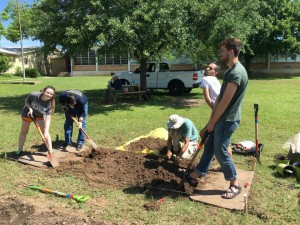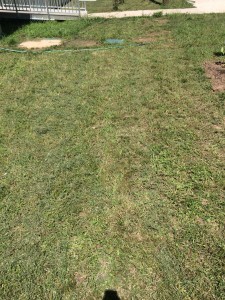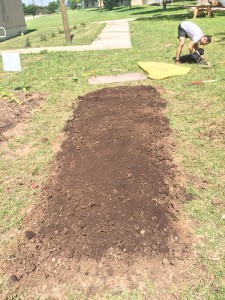So far, I’ve focused mainly on my personal experiences with nature and how it’s affected my mood. Part I is dedicated to urban green spaces and its personal wellbeing benefits. Part II delves deeper into ecotherapy literature and resumes focus on my personal experience – and you’ll want to read that next post.
Part I: Green Spaces + Service Learning
Deeply rooted in Holy Cross values, St. Edward’s University encourages its students to engage in service learning opportunities, which ultimately seeks to create positive change. Simply, we love volunteering and we don’t mind getting our hands dirty.
We partnered with Green Corn Project (GCP) on a beautiful Saturday morning. GCP is a volunteer-run nonprofit dedicated to educating and assisting Central Texans in growing affordable, organic foods and promoting sustainability. Their vision is to strengthen a community by installing gardens to beautify the landscape, conserve natural resources, and promote self-reliance. Many of their clients include elementary schools, community centers, and low-income, elderly, or disabled citizens.
For today’s journey, we set out to an Alternative Learning Center, a school that aims to provide opportunity to students with disciplinary and social challenges. The truth is that these schools rarely invest in “extra” things like landscaping. Thankfully, GCP decided it was time for a change. The garden area is not only meant to educate students about gardening and sustainability, but also to provide a green space for everyone to enjoy.
Our GCP-guru David compiled all the tools, mulch, and seeds required to get the job done. We brought eight volunteers to dig a 4×12 foot garden, which only took about three and a half hours. David taught us the GCP ways of gardening: the biointensive method. First we started by double digging. This method includes, you guessed it, digging and then re-digging in order to loosen the soil, which allows roots to grow more efficiency in tiny spaces. (More roots = more plants.) We started by mowing the grass, pulling the weeds, forking the soil, digging the soil, redigging the soil, forking some more, and finally layering it with compost and racking the surface sooth. By double digging, the little plantlings get more nutrients/water while staying stable in the soil – so that’s less upkeep and money for the school.
David brought out the seeds. After scattering a packet in his pickup truck, we collected enough seeds to plant half the garden. We gently planted them a couple inches in the dirt. The biointensive method proved to be a bit labor intensive, but also inexpensive and much more efficient than the anyway I would’ve approached gardening. Sidenote: I’m also the type to kill all my succulents (I’m so, so sorry my plantlings!), so gardening was a way of redeeming myself.
It’s About The Cause, and The Cause and Effect
Installing a garden at an Alternative Learning Center is a great way to educate the students – but does it impact their health – specifically mental health? Depends. The whole point of the garden is to get students outside for a more hands-on learning experience. David added that several of the students actually knew how to garden because one or both of their parents worked in landscaping. Unfortunately, I couldn’t talk to any school administration, but the school could use this as a leadership opportunity for students interested in garden upkeep. In addition, this allows a space for students to enjoy their leisure-time, especially with the large, grassy area and a shady tree accompanied with a picnic bench a couple feet away. Along with many other expert studies, the Environmental Health Research Foundation found that simply viewing or being in a green space for a few minutes reduces stress (Heinze 24).
The Importance of Volunteering
The best thing about volunteering is being apart of something bigger than you. In addition to creating an educational opportunity, we had so much fun building the garden (and playing with a friendly dog!) Since we were currently gearing up for finals, the mental break was rejuvenating and calming. Something about pulling stubborn weeds, digging into the hard dirt, and breaking a sweat made me feel happier and calmer. That, my friends, is where Part II begins.
Sources
“GCP” http://www.greencornproject.org/about_us
Heinze, John, Ph.D. Benefits of Green Space – Recent Research. Rep. Environmental Health Research Foundation (EHRF), 25 Apr. 2011. Web. 1 May 2016.



